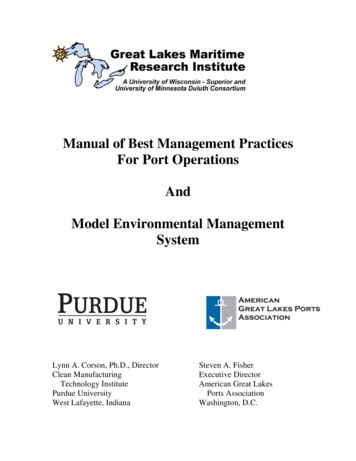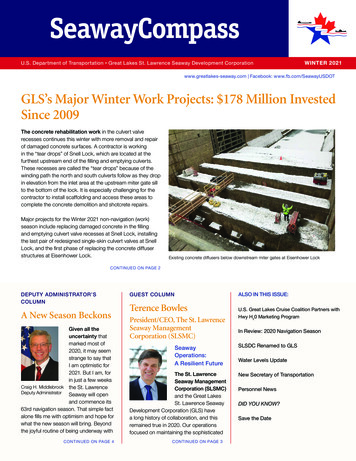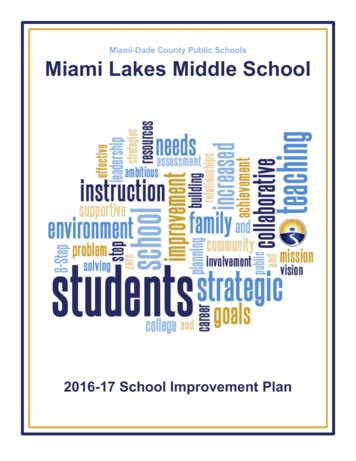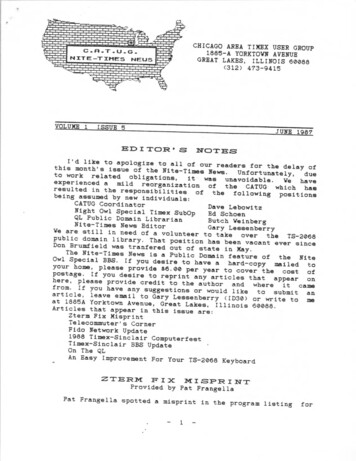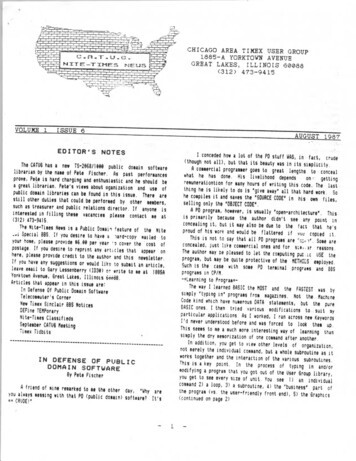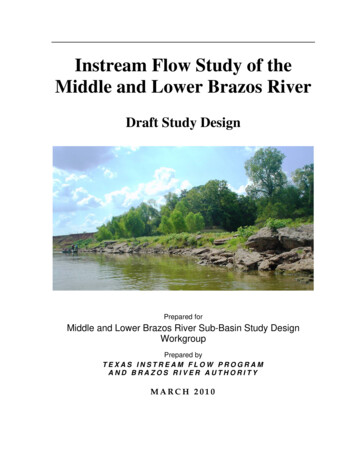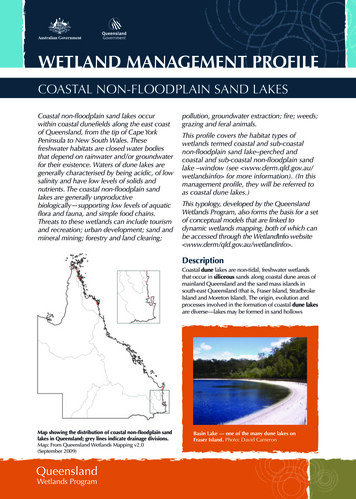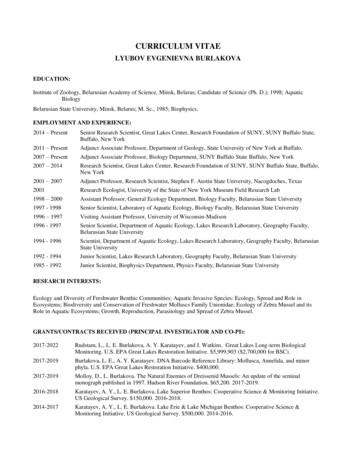
Transcription
CURRICULUM VITAELYUBOV EVGENIEVNA BURLAKOVAEDUCATION:Institute of Zoology, Belarusian Academy of Science, Minsk, Belarus; Candidate of Science (Ph. D.); 1998; AquaticBiologyBelarusian State University, Minsk, Belarus; M. Sc., 1985; Biophysics.EMPLOYMENT AND EXPERIENCE:2014 – PresentSenior Research Scientist, Great Lakes Center, Research Foundation of SUNY, SUNY Buffalo State,Buffalo, New York2011 – PresentAdjunct Associate Professor, Department of Geology, State University of New York at Buffalo.2007 – PresentAdjunct Associate Professor, Biology Department, SUNY Buffalo State Buffalo, New York2007 – 2014Research Scientist, Great Lakes Center, Research Foundation of SUNY, SUNY Buffalo State, Buffalo,New York2001 – 2007Adjunct Professor, Research Scientist, Stephen F. Austin State University, Nacogdoches, Texas2001Research Ecologist, University of the State of New York Museum Field Research Lab1998 – 2000Assistant Professor, General Ecology Department, Biology Faculty, Belarusian State University1997 - 1998Senior Scientist, Laboratory of Aquatic Ecology, Biology Faculty, Belarusian State University1996 – 1997Visiting Assistant Professor, University of Wisconsin-Madison1996 - 1997Senior Scientist, Department of Aquatic Ecology, Lakes Research Laboratory, Geography Faculty,Belarusian State University1994 - 1996Scientist, Department of Aquatic Ecology, Lakes Research Laboratory, Geography Faculty, BelarusianState University1992 - 1994Junior Scientist, Lakes Research Laboratory, Geography Faculty, Belarusian State University1985 - 1992Junior Scientist, Biophysics Department, Physics Faculty, Belarusian State UniversityRESEARCH INTERESTS:Ecology and Diversity of Freshwater Benthic Communities; Aquatic Invasive Species: Ecology, Spread and Role inEcosystems; Biodiversity and Conservation of Freshwater Molluscs Family Unionidae; Ecology of Zebra Mussel and itsRole in Aquatic Ecosystems; Growth, Reproduction, Parasitology and Spread of Zebra Mussel.GRANTS/CONTRACTS RECEIVED (PRINCIPAL INVESTIGATOR AND CO-PI):2017-2022Rudstam, L., L. E. Burlakova, A. Y. Karatayev, and J. Watkins. Great Lakes Long-term BiologicalMonitoring. U.S. EPA Great Lakes Restoration Initiative. 5,999,903 ( 2,700,000 for BSC).2017-2019Burlakova, L. E., A. Y. Karatayev. DNA Barcode Reference Library: Mollusca, Annelida, and minorphyla. U.S. EPA Great Lakes Restoration Initiative. 400,000.2017-2019Molloy, D., L. Burlakova. The Natural Enemies of Dreissenid Mussels: An update of the seminalmonograph published in 1997. Hudson River Foundation. 65,200. 2017-2019.2016-2018Karatayev, A. Y., L. E. Burlakova. Lake Superior Benthos: Cooperative Science & Monitoring Initiative.US Geological Survey. 150,000. 2016-2018.2014-2017Karatayev, A. Y., L. E. Burlakova. Lake Erie & Lake Michigan Benthos: Cooperative Science &Monitoring Initiative. US Geological Survey. 500,000. 2014-2016.
Lyubov E. Burlakova CV - Page 22014-2018Karatayev, A. Y., L. E. Burlakova, and G. Gorsky. Investigating Lake Sturgeon habitat use, feedingecology and benthic resource availability in the lower Niagara River. Ecological Greenway Fund. 835,829.2012-2018Rudstam, L., A. Y. Karatayev, L. E. Burlakova. Great Lakes Long-Term Biological Monitoring ofZooplankton, Benthos, and Chlorophyll a. U.S. EPA. 3,867,525 ( 1,094,726 for BSC).2012-2013Snyder, R. J., L. E. Burlakova, D. B. MacNeill, and A. Y. Karatayev. Enhanced Early Detection ofInvasive Ponto-Caspian Fishes in the Great Lakes. U.S. EPA Great Lakes Restoration Initiative. 99,756.2012-2013Burlakova, L. E., A.Y. Karatayev. Zebra/Quagga Mussel Viability Test. U.S. Fish and Wildlife Service,Pacific Region. 24,962.2010-2013Burlakova, L. E., A.Y. Karatayev, M. E. May, and B. Lang. Survey of Texas Hornshell Populations inTexas. U.S. Fish and Wildlife Service and Texas Parks and Wildlife Department, Traditional Section 6Joint Project with New Mexico Department of Game and Fish. 143,000.2011-2012Burlakova, L. E., A. Y. Karatayev, M. E. May, M. D. Warriner, and B. Gottfried. Survey ofthreatened freshwater mussels (Bivalvia: Unionidae) in Texas. State Wildlife Grant Program, U.S.Fish and Wildlife Service, and Texas Parks and Wildlife Department. 38,000.2011-2013Zanatta, D., L. E. Burlakova, A. Y. Karatayev, R. Krebs, M. Hoggarth, F. de Szalay, J. Bossenbroek,E. Meyer, M. Walsh. Collaborators: M. Schlesinger, R. Haas, T. Crail, P. Badra, N. Welte, and L.Holst. Conservation of Native Freshwater Mussel Refuges in Great Lakes Coastal Zones. Great LakesFish and Wildlife Restoration Act, U. S. Fish and Wildlife Service. 366,412.2011-2013Pennuto, C. M., A. Y. Karatayev, A. Pérez-Fuentetaja, L.E. Burlakova, D. Bade, G. Matisoff, J.Kramer, and C. Mayer. The Lake Erie Nearshore and Offshore Nutrient Study (LENONS). U.S. EPAGreat Lakes Restoration Initiative. 615,813.2010-2011Snyder, R. J., L. E. Burlakova, D. B. MacNeill, and A. Y. Karatayev. Evaluating Ponto-CaspianFishes for Risk of Great Lakes Invasion. U.S. EPA Great Lakes Restoration Initiative. 111,264.2010Burlakova. L., A. Karatayev, and M. Goehle. Preliminary Risk Assessment of the Parasites of AquaticExotic Invertebrates in the Great Lakes Region. New York Great Lakes Protection Fund Small GrantsProgram (Great Lakes Research Consortium, New York Department of Environmental Conservation,New York Great Lakes Basin Advisory Council). 9,473.2009Pennuto, C.M., A.Y. Karatayev, A. Pérez-Fuentetaja, L.E. Burlakova, G. Matisoff, J. Kramer, and J.Conroy. The Nearshore and Offshore Lake Erie Nutrient Study (NOLENS). U.S. EPA. 150,000.2008-2009Burlakova, L. E. and A. Y. Karatayev. State-Wide Assessment of Unionid Diversity in Texas. StateWildlife Grant Program, U.S. Fish and Wildlife Service. 67,514.2007-2008Karatayev, A. Y. and L. E. Burlakova. Effect of Natural Factors on Rate of Spread of AquaticInvasive Species. Buffalo State College Research Council Incentive Funds. 6,284.2007-2008Burlakova, L. E. and A. Y. Karatayev. State-Wide Assessment of Unionid Diversity in Texas. StateWildlife Grant Program, U.S. Fish and Wildlife Service. 69,375.2006-2009Burlakova, L. E. and A. Y. Karatayev. Assessing Potential Impacts of Channeled Applesnail toWetlands in the Galveston Bay Watershed. Texas Commission on Environmental Quality. 20,000.2006-2007Burlakova, L. E. and A. Y. Karatayev. East Texas Mussel Surveys. State Wildlife Grants, U.S. Fishand Wildlife Service. Texas Parks and Wildlife Department. 32,056.2006-2007Karatayev, A. Y. and L. E. Burlakova. Status of Invasive Freshwater Mollusks in Texas. StateWildlife Grants, U.S. Fish and Wildlife Service. Texas Parks and Wildlife Department. 17,795.2006-2007Burlakova, L. E. and A. Y. Karatayev. Distributional survey and habitat utilization of freshwatermussels. Texas Water Development Board. 65,000.2006-2007Karatayev, A. Y. and L. E. Burlakova. Predicting the spread and ecosystem impact of exotic bivalveLimnoperna fortunei on North American freshwaters. SFA Faculty Research Grant. 15,704.
Lyubov E. Burlakova CV - Page 32006-2008Karatayev, A. Y. and L. E. Burlakova Potential effects of Zebra mussels in the Madison lakes.Wisconsin DNR Aquatic Invasive Species Grants Program. 49,037.2004-2006Freshwater mussel survey in Texas. State Wildlife Grants, U.S. Fish and Wildlife Service. TexasParks and Wildlife Department. 120,000.2006SFA Research Enhancement Minigrant. 500.2004-2006Assessing potential impacts of Channeled Applesnail to wetlands in the Galveston Bay watershed.U.S. Fish and Wildlife Service, Texas Commission on Environmental Quality, and USDACooperative Agriculture Pest Survey (CAPS) Program for 2005 surveys. 117,544.2006SFA Research Enhancement Minigrant. 750.2004-2006Survey of Benthic Macroinvertebrates at Texas Army National Guard (TXARNG) Facility FortWolters, Parker County, Texas. Texas Army National Guard. 16,0242003-2005The impact of invasive molluscs Corbicula fluminea and Dreissena polymorpha on benthiccommunities of aquatic ecosystems. SFA Faculty Research Grant. 15,872.2003-2005Monitoring of Unionid Populations at Texas Army National Guard (TXARNG) Facility Camp Maxey,Lamar County, Texas. Texas Army National Guard. 44,900.2003-2005Survey of Benthic Macroinvertebrates at Texas Army National Guard (TXARNG) Facility Camp Swift,Bastrop County, Texas. Texas Army National Guard. 15,800.2003-2004Survey of Benthic Macroinvertebrates at Texas Army National Guard (TXARNG) Facility Camp Maxey,Lamar County, Texas. Texas Army National Guard. 15,500.1998-2000Study the Potential Spread of Zebra Mussels and Develop Fundamentals of Impact of Species-filtrator onWater Ecosystems using Lakes of Belarus and United States as an Example. Ministry for Education andScience Republic of Belarus. 1,000.1995-1997Study of Zebra Mussel Effects on Ecological Systems of Belarusian Lakes and Development of Methodsfor Using Zebra Mussels to Improve Water Quality and Increase Fish Productivity. Ministry for Educationand Science Republic of Belarus. 12,000.1993-1994Development of a Mathematical Model of the Ecological System of Lake Lukomskoe. NovolukomskijTown Executive Committee. 2,200.1990-1991Environmental Monitoring of Lukomskoe Lake Focusing on Anthropogenic Influences. NovolukomlskayaThermal Electric Power Plant. 800.PROFESSIONAL PUBLICATIONS AND PRESENTATIONS:Peer-review Publications: 97Presentations at Scholarly Meetings and Invited Talks: 95Papers in Proceedings: 11Published Abstracts: 170PUBLICATIONS:REVIEWED PUBLICATIONS:Gerasimova, L. K., L. E. Burlakova, and B. A. Tatarinov. 1985. Comparative study of the effect of ultraviolet rays, alpharadiation and ozone on apple induviate tissue. Vestnik Belorusskogo Universiteta. Ser. 2 (3): 14-18. (in Russian).Zhukovskaya, L. N., L. E. Burlakova, L. E. Gorbatsevich, T. M. Novikova, B. A. Tatarinov, and S. N. Ustichenko. 1988.Efficiency of short-term methods for storage of fruits and vegetables at high temperatures. Vestsi Akademii NavukBSSR. Seriya selskagaspadarchikh navuk 1. Dep. in VNIITISX, 11, BC-87, Dep. 24 p. (in Russian).Tatarinov, B. A., T. M. Novikova, L. N. Zhukovskaya, and L. E. Burlakova. 1988. Methods for storage of fruits and berriestransporting in airplane containers at high temperatures. Vestsi Akademii Navuk BSSR. 2: 11-18. (in Russian).
Lyubov E. Burlakova CV - Page 4Karatayev, A. Y., and L. Y. Burlakova. 1992. Changes in tropic structure of macrozoobenthos of an eutrophic lake, afterinvasion of Dreissena polymorpha. Biologiya Vnutrennikh Vod. Inform. Byull. 93: 67-71 (in Russian).Karatayev, A. Y., I. A. Rudakovskiy, and L. E. Burlakova. 1993. Cs 137-distribution and dynamic in the lakes withdifferent levels of radioactive contamination. Vestnik Belorusskogo Universiteta. Ser. 2 (3): 57-61 (in Russian).Karatayev, A. Y., and L. E. Burlakova. 1994. The rate of filtration. In: Y. I. Starobogatov (ed.). Freshwater Zebra MusselDreissena polymorpha (Pall.) (Bivalvia, Dreissenidae). Systematic, Ecology, Practical Meaning, pp. 132-137.Nauka Press, Moscow (in Russian).Karatayev, A. Y., V. P. Lyakhnovich, S. A. Afanasiev, L. E. Burlakova, V. P. Zakutskiy, S. M. Lyakhov, M. P.Miroshnichenko, T. G. Moroz, M. Y. Nekrasova, S. P. Nechvalenko, I. A. Skalskaya, T. G. Kharchenko, and A. A.Protasov. 1994. The place of species in ecosystem. In: Y. I. Starobogatov (ed.) Freshwater Zebra Mussel Dreissenapolymorpha (Pall.) (Bivalvia, Dreissenidae). Systematic, Ecology, Practical Meaning, pp. 180-195. Nauka Press,Moscow (in Russian).Karatayev, A. Y., and L. E. Burlakova. 1995. Present and further patterns in Dreissena polymorpha (Pallas) populationdevelopment in the Narochanskaya lakes system. Vestsi Akademii Navuk Belarusi. Seriya biyalagichnikh navuk 3:95-99 (in Belarussian).Karatayev, A. Y., and L. E. Burlakova. 1995. The role of Dreissena in lake ecosystems. Russian Journal of Ecology26(3): 207-211. Translated from Ecologiya 26(3), 1995, pp. 232-236. (in English).Karatayev, A. Y., V. M. Samoilenko, L. E. Burlakova, Z. K. Kartashevich, and A. N. Rachevskij. 1995. Recommendationsfor the Restoration of Lakes under Strong Anthropogenic Influence. Belgosuniversitet Press, Minsk. 73 p. (inRussian).Karatayev, A. Y., L. E. Burlakova, I. A. Rudakovskiy, and Z. K. Kartashevich. 1996. Radioactive contamination ofBelarussian lakes. In: T. V. Belookaya et al. (eds.) Ecological anthropology. Annual issue, pp. 46-58. BelarussianCommittee “Deti Chernobilya” Press, Minsk (in Russian with English summary).Molloy, D. P., A. Y. Karatayev, L. E. Burlakova, D. P. Kurandina, and F. Laruelle. 1997. Natural Enemies of ZebraMussels: Predators, Parasites and Ecological Competitors. Reviews in Fisheries Science 5(1): 27-97.Karatayev, A. Y., L. E. Burlakova, and D. K. Padilla. 1997. The effect of Dreissena polymorpha (Pallas) invasion onaquatic communities in Eastern Europe. Journal of Shellfish Research 16(1): 187-203.Burlakova, L. E., A. Y. Karatayev, and D. P. Molloy. 1998. Field and laboratory studies of zebra mussel (Dreissenapolymorpha) infection by the ciliate Conchophthirus acuminatus in the Republic of Belarus. Journal of InvertebratePathology 71(3): 251-257.Burlakova, L. E. 1998. Ecology of mussel Dreissena polymorpha (Pallas) and its role in structure and function of aquaticecosystems. Candidate Dissertation, Zoology Institute of the Academy of Science Republic Belarus, Minsk, Belarus,168 pp. (in Russian with English abstract).Karatayev, A. Y., L. E. Burlakova, and D. K. Padilla. 1998. Physical factors that limit the distribution and abundance ofDreissena polymorpha (Pall.). Journal of Shellfish Research 17(4): 1219-1235.Karatayev, A. Y., L. E. Burlakova, and D. P. Molloy. 2000. Seasonal dynamics of Conchophthirus acuminatus(Ciliophora, Conchophthiridae) infection in Dreissena polymorpha and D. bugensis (Bivalvia, Dreissenidae).European Journal of Protistology. 36, pp. 397-404.Karatayev, A. Y., L. E. Burlakova, D. P. Molloy, and L. K. Volkova. 2000. Endosymbionts of Dreissena polymorpha(Pallas) in Belarus. International Review of Hydrobiology. 85(5-6), pp. 543-559.Burlakova, L. E., A. Y. Karatayev, and D. K. Padilla. 2000. The impact of Dreissena polymorpha (Pallas) invasion onunionid bivalves. International Review of Hydrobiology. 85(5-6). pp. 529-541.Kraft C. E., P. J. Sullivan, A. Y. Karatayev, L. E. Burlakova, J. C. Nekola, L. E. Johnson, and D. K. Padilla. 2002.Landscape patterns of an aquatic invader: assessing dispersal extent from spatial distributions. EcologicalApplications – 12(3): 749-759.Karatayev, A. Y., L. E. Burlakova, D. P. Molloy, L. K. Volkova, and V. V. Volosyuk. 2002. Field and laboratory studies ofOphryoglena sp. (Ciliata: Ophryoglenidae) infection in zebra mussels, Dreissena polymorpha (Bivalvia:Dreissenidae) Journal of Invertebrate Pathology 79(2002): 80-85.Karatayev, A. Y, L. E. Burlakova and D. K. Padilla. 2002. Impacts of Zebra Mussels on aquatic communities and their roleas ecosystem engineers. In: Leppäkoski, E., S. Gollasch and S. Olenin (eds). Invasive Aquatic Species of Europe Distribution, Impacts and Management. Kluwer Academic Publishers, Dordrecht, The Netherlands, pp 433-446.
Lyubov E. Burlakova CV - Page 5Karatayev A. Y., S. E. Mastitsky, L. E. Burlakova, D. P. Molloy, and G. G. Vezhnovets. 2003. Seasonal dynamics ofendosymbiotic ciliates and nematodes in Dreissena polymorpha. Journal of Invertebrate Pathology 83 (1): 73-82.Karatayev, A. Y., S. E. Mastitsky, D. P. Molloy, and L. E. Burlakova. 2003. Patterns of emergence and survival ofConchophthirus acuminatus (Ciliophora: Conchophthiridae) from Dreissena polymorpha (Bivalvia: Dreissenidae)Journal of Shellfish Research 22(1): 495-500.Karatayev A. Y., L. E. Burlakova, T. Kesterton, and K. Padilla. 2003. Dominance of the Asiatic clam, Corbicula fluminea(Müller) in the benthic community of a reservoir. Journal of Shellfish Research 22(2): 487-493.Karatayev A.Y., L. E. Burlakova, D. K. Padilla, and L. E. Johnson. 2003. Patterns of spread of the zebra mussel (Dreissenapolymorpha (Pallas)): the continuing invasion of Belarussian lakes. Biological Invasions. 5(3): 213-221.Howells, R. G., J. B. Wise, A. Y. Karatayev, and L. E. Burlakova. 2004. New "old records" of Asian clam Corbiculafluminea in Texas. Ellipsaria 6(3):11. (Scientific note).Karatayev, A. Y., L. E. Burlakova, and D. K. Padilla. 2005. Contrasting distribution and impacts of two freshwater exoticsuspension feeders, Dreissena polymorpha and Corbicula fluminea. In: R. Dame and S. Olenin (eds.) TheComparative Roles of Suspension Feeders in Ecosystems. NATO Science Series: IV – Earth and EnvironmentalSciences. Springer, pp 239-262.Burlakova, L. E., A. Y. Karatayev, and D. K. Padilla. 2005. Functional changes in benthic freshwater communities afterDreissena polymorpha (Pallas) invasion and consequences for filtration. In: R. Dame and S. Olenin (eds.) TheComparative Roles of Suspension Feeders in Ecosystems. NATO Science Series: IV – Earth and EnvironmentalSciences. Springer, pp 263-275.Karatayev, A. Y., R. G. Howells, L. E. Burlakova, and B. D. Sewell. 2005. History of spread and current distribution ofCorbicula fluminea (Müller) in Texas. Journal of Shellfish Research 24(2): 553-559.Karatayev A. Y., L. E. Burlakova, and S. I Dodson. 2005. Community analysis of Belarusian lakes: relationship of speciesdiversity to morphology, hydrology, and land use. Journal of Plankton Research. 27(10): 1045-1053.Burlakova, L. E., D. K. Padilla, A.Y. Karatayev, and D. Minchin. 2006. Endosymbionts of Dreissena polymorpha inIreland: evidence for the introduction of adult mussels. Journal of Molluscan Studies. 72: 207-210.Karatayev, A.Y., L. E. Burlakova, and D. K. Padilla. 2006. Growth rate and longevity of Dreissena polymorpha (Pallas): areview and recommendations for future study. Journal of Shellfish Research. 25(1): 23-32.Burlakova, L. E., A. Y. Karatayev, and D. K. Padilla. 2006. Changes in the distribution and abundance of Dreissenapolymorpha within lakes through time. Hydrobiologia. 571:133–146.Howells, R. G., L. E. Burlakova, A. Y. Karatayev, R. K. Marfurt, and R. L. Burks. 2006. Native and introducedAmpullaridae in North America: history, status, and ecology. In: R. C. Joshi, L. S. Sebastian, eds. Global Advancesin Ecology and Management of Golden Apple Snails. Philippine Rice Research Institute (PhilRice), Philippines. 73112.Karatayev, A. Y., D. K. Padilla, D. Minchin, D. Boltovskoy, and L E. Burlakova. 2007. Changes in global economies andtrade: the potential spread of exotic freshwater bivalves. Biological Invasions. 9:161–180.Karatayev, A. Y., D. Boltovskoy, D. K. Padilla, and L. E. Burlakova. 2007. The invasive bivalves Dreissena polymorphaand Limnoperna fortunei: parallels, contrasts, potential spread and invasion impacts. Journal of Shellfish Research.26 (1): 205-213.Burlakova, L. E., and A. Y. Karatayev. 2007. The effect of invasive macrophytes and water level fluctuations on unionids inTexas impoundments. Hydrobiologia. 586: 291-302.Karatayev, A. Y., L. E. Burlakova, D. P. Molloy, and S. E. Mastitsky. 2007. Dreissena polymorpha and Conchophthirusacuminatus: What can we learn from host-commensal relationships. Journal of Shellfish Research. 26:1153-1160.Karatayev, A. Y., L. E. Burlakova, S. E. Mastitsky, and S. Olenin. 2008. Past, current, and future of the Central EuropeanCorridor for aquatic invasions in Belarus. Biological Invasions. 10: 215-232.Karatayev, A. Y., L. E. Burlakova, and S. I. Dodson. 2008. Community analysis of Belarusian lakes: correlations of speciesdiversity with hydrochemistry. Hydrobiologia. 605: 99-112.Burlakova, L. E., A. Y. Karatayev, D. K. Padilla, L. D. Cartwright, and D. N. Hollas. 2009. Wetland restoration andinvasive species: applesnail (Pomacea insularum) feeding on native and invasive aquatic plants. RestorationEcology. 17(3): 433-440.
Lyubov E. Burlakova CV - Page 6Karatayev, A. Y., L. E. Burlakova, V. A. Karatayev, and D. K. Padilla. 2009. Introduction, distribution, spread, and impactsof exotic freshwater gastropods in Texas. Hydrobiologia. 619: 181-194.Karatayev, A. Y., L. E. Burlakova, D. K. Padilla, S. E. Mastitsky, S. Olenin. 2009. Invaders are not a random selection ofspecies. Biological Invasions. 11: 2009-2019.Boltovskoy, D., A. Karatayev, L. Burlakova, D. Cataldo, V. Karatayev, F. Sylvester, and A. Mariňelarena. 2009. Significantecosystem-wide effects of the swiftly spreading invasive freshwater bivalve Limnoperna fortunei. Hydrobiologia636: 271-284.Burlakova, L. E., D. K. Padilla, A.Y. Karatayev, D. N. Hollas, L. D. Cartwright, and K. D. Nichol. 2010. Differences inpopulation dynamics and potential impacts of a freshwater invader driven by temporal habitat stability. BiologicalInvasions 12(4): 927-942.Mastitsky, S. E. A. Y. Karatayev, L. E.Burlakova, and B. V. Adamovich. 2010. Non-native fishes of Belarus: diversity,distribution, and risk classification using the Fish Invasiveness Screening Kit (FISK). Aquatic Invasions 5(1): 103114. http://www.aquaticinvasions.ru/2010/AI 2010 5 1 Mastitsky etal.pdfMolloy, D. P. , L. Giamberini, L. E. Burlakova, A. Y. Karatayev, J. R. Cryan, S. L. Trajanovski, and S. P. Trajanovska.2010. Investigation of the endosymbionts of Dreissena stankovici with morphological and molecular confirmation.Chapter 23 in G. van der Velde, S. Rajagopal and A. bij de Vaate (eds), The Zebra Mussel in Europe. BackhuysPublishers, Leiden/Margraf Publishers, Weikersheim. p. 227-238.Karatayev, A.Y., L. E. Burlakova, and D. K. Padilla. 2010. Dreissena polymorpha in Belarus: history of spread, populationbiology, and ecosystem impacts. Chapter 9 in G. van der Velde, S. Rajagopal and A. bij de Vaate (eds), The ZebraMussel in Europe. Backhuys Publishers, Leiden/ Margraf Publishers, Weikersheim. p. 101-112.Mastitsky, S. E., A. Y. Karatayev, L. E. Burlakova, and D. P. Molloy. 2010. Parasites of exotic species in invaded areas:does lower diversity mean lower epizootic impact? Diversity and Distributions 16: 798–803.Karatayev, A. Y., L. E. Burlakova, V. A. Karatayev, and D. Boltovskoy. 2010. Limnoperna fortunei vs. Dreissenapolymorpha: Population densities and benthic community impacts of two invasive freshwater bivalves. Journal ofShellfish Research 29(4): 975-985.Karatayev, A. Y., S. E. Mastitsky, D. K. Padilla, L. E. Burlakova, and M. M. Hajduk. 2011. Differences in growth andsurvivorship of zebra and quagga mussels: size matters. Hydrobiologia 668(1):183-194.Burlakova, L. E., Karatayev, A. Y. Karatayev, V. A., M. E. May, Bennett, D. L., and Cook, M. J. 2011. Endemic species:contribution to community uniqueness, effect of habitat alteration, and conservation priorities. BiologicalConservation 144: 155–165.Burlakova, L. E., A. Y. Karatayev, V. A. Karatayev, M. E. May, D. L. Bennett, and M. J. Cook. 2011. Biogeography andconservation of freshwater mussels (Bivalvia: Unionidae) in Texas: Patterns of diversity and threats. Diversity andDistributions. 17: 393-407.Karatayev, A. Y., L. E. Burlakova, S. E. Mastitsky, D. K. Padilla, and E. L. Mills. 2011. Contrasting rates of spread of twocongeners, Dreissena polymorpha and Dreissena rostriformis bugensis, at different spatial scales. Journal ofShellfish Research 30(3): 1–9.Burlakova, L. E., A. Y. Karatayev, and V. A. Karatayev. 2012. Invasive mussels induce community changes by increasinghabitat complexity. Hydrobiologia 685(1): 121-134.Karatayev, A. Y., T. D. Miller, and L. E. Burlakova. 2012. Long-term changes in unionid assemblages in the Rio Grande,one of the World’s top 10 rivers at risk. Aquatic Conservation: Marine and Freshwater Ecosystems. 22(2): 206-219.Burlakova L. E., D. Campbell, A. Y. Karatayev, and D. Barclay. 2012. Distribution, genetic analysis and conservationpriorities for rare Texas freshwater molluscs in the genera Fusconaia and Pleurobema (Bivalvia: Unionidae). AquaticBiosystems 8(1):12. Open Access article atayev, A. Y., S. E. Mastitsky, L. E. Burlakova, V. A. Karatayev, M. M. Hajduk, and D. B. Conn. 2012. Exotic molluscsin Great Lakes host epizootically important trematodes. Journal of Shellfish Research. 31(3):885-894.Lucy, F. E., Karatayev, A. Y., and L. E. Burlakova. 2012. Predictions for the spread, population density, and impacts ofCorbicula fluminea in Ireland. Aquatic Invasions 7 /AI 2012 4 Lucy etal.pdfKaratayev, A. Y., L. E. Burlakova, J. Vander Zanden, R. C. Lathrop, and D. K. Padilla. 2013. Change in a lake benthiccommunity over a century: evidence for alternative community states. Hydrobiologia 700:287–300.
Lyubov E. Burlakova CV - Page 7Molloy, D. P., D. A. Mayer, M. J. Gaylo, J. T. Morse, K. T. Presti, P. M. Sawyko, A. Y. Karatayev, L. E. Burlakova, F.Laruelle, K. C. Nishikawa, and B. H. Griffin. 2013. Pseudomonas fluorescens strain CL145A – A biopesticide forthe control of zebra and quagga mussels (Bivalvia: Dreissenidae). Journal of Invertebrate Pathology 113 (2013):104–114. http://dx.doi.org/10.1016/j.jip.2012.12.012Molloy, D. P., D. A. Mayer, M. J. Gaylo, L. E. Burlakova, A. Y. Karatayev, K. T. Presti, P. M. Sawyko, J. T. Morse, and E.A. Paul. 2013. Non-target trials with Pseudomonas fluorescens strain CL145A, a lethal control agent of dreissenidmussels (Bivalvia: Dreissenidae). Management of Biological Invasions 4(1): 71–79. Open Access article ayev, V. A., Karatayev, A. Y., L. E. Burlakova, and D. K. Padilla. 2013. Lakewide dominance does not predict theinvader species for dreissenids. Journal of Great Lakes Research 39(4): cle/pii/S0380133013001329.Randklev, C.R., E.T. Tsakiris, M.S. Johnson, J. Skorupski, L.E. Burlakova , J. Groce, and N. Wilkins. 2013. Is False Spike,Quadrula mitchelli (Bivalvia: Unionidae), extinct? First account of a very-recently deceased individual in over thirtyyears. The Southwestern Naturalist 58: 247-259.Karatayev, A. Y., L. E. Burlakova, and D. K. Padilla. 2014. General Overview of Zebra and Quagga Mussels: What WeDo And Do Not Know. In T. F. Nalepa and D. W. Schloesser (eds.) Quagga and Zebra Mussels: Biology, Impacts,and Control. 2nd Edition. CRC Press, Boca Raton, FL. pp. 695-703.Mayer, C. M., Burlakova, L. E., Eklöv, P., Fitzgerald, D., Karatayev, A. Y., Ludsin, S. A., Millard, S., Mills, E. L.,Ostapenya, A. P., Rudstam, L. G., Zhu, B., and Zhukova, T. V. 2014. Benthification of Freshwater Lakes: ExoticMussels Turning Ecosystems Upside Down. In T. F. Nalepa and D. W. Schloesser (eds.) Quagga and Zebra Mussels:Biology, Impacts, and Control. 2nd Edition. CRC Press, Boca Raton, FL. pp. 575-586.Lucy, F. E., Burlakova, L. E., Karatayev, A. Y., Mastitsky, S. E., Zanatta, D. T. 2014. Zebra Mussel Impacts on Unionids:A Synthesis of Trends in North America and Europe. In T. F. Nalepa and D. W. Schloesser (eds.) Quagga and ZebraMussels: Biology, Impacts, and Control. 2nd Edition. CRC Press, Boca Raton, FL. pp. 623-646.Mastitsky, S. E., A. Y. Karatayev, and L. E. Burlakova. 2014. Parasites of aquatic exotic invertebrates: identification ofhazards posed to the Great Lakes. Human and Ecological Risk Assessment. 20:743-763.Burlakova, L. E., A. Y. Karatayev, C. Pennuto, and C. Mayer. 2014. Changes in Lake Erie benthos over the last 50 years:historical perspectives, current status, and main drivers. Journal of Great Lakes Research. 40: 08Karatayev, A. Y., L. E. Burlakova, C. Pennuto, J. Ciborowski, V. A. Karatayev, P. Juette, and M. Clapsadl. 2014. Twentyfive years of changes in Dreissena spp. populations in Lake Erie. Journal of Great Lakes Research. 40: 10.Snyder, R. J., L. E. Burlakova, A.Y. Karatayev, and D. B. MacNeill. 2014. Updated Invasion Risk Assessment for PontoCaspian Fishes to the Great Lakes. Journal of Great Lakes Research. 40: 09Pennuto, C. M., L. E. Burlakova, A. Y. Karatayev, J. Kramer, A. Fisher, and C. Mayer. 2014. Spatiotemporal characteristicsof nitrogen and phosphorus in the benthos of nearshore Lake Erie. Journal of Great Lakes 013Karatayev, A. Y., L. E. Burlakova, and D. K. Padilla. 2014. Zebra versus quagga mussels: a review of their spread,population dynamics, and ecosystem impacts. Hydrobiologia. 746 (1): 97-112.Karatayev, V. A., Karatayev, A. Y., L. E. Burlakova, and L. G. Rudstam. 2014. Eutrophication and Dreissena invasion asdrivers of biodiversity: a century of change in the mollusc community of Oneida Lake. PLOS ONE 9(7): , L.E., Tulumello, B.T., Karatayev, A.Y., Krebs, R.A., Schloesser, D.W., Paterson, W.L., Griffith, T.A., Scott,M.W., Crail, T., and D.T. Zanatta, 2014. Competitive replacement of invasive congeners may relax impact on nativespecies: interactions among zebra, quagga, and native unionid mussels. PLoS ONE,DOI:10.1371/journal.pone.0114926.Karatayev, A.Y., Burlakova, L.E., Mastitsky, S.E., and D. K. Padilla. 2015. Predicting the spread of aquatic invaders:insight from 200 years of invasion by zebra mussels. Ecological Applications 25: 430–440.http://dx.doi.org/10.1890/13-1339.1
Lyubov E. Burlakova CV - Page 8Zanatta, D.T., Bossenbroek, J.M., Burlakova, L.E., Crail, T., de Szalay, F., Griffith, T.A., Kapusinski, D., Karatayev, A.Y.,Krebs, R.A., Meyer, E.S., Paterson, W.L., Prescott, T.J., Rowe, M.T., Schloesser, D.W., and M.C. Walsh. 2015.Distribution of native mussel (Unionidae) assemblages in coastal areas of Lake Erie, Lake St. Clair, and connectingchannels, twenty-five years after a dreissenid invasion. Northeastern Naturalist, 22(1): 223–235.Karatayev, A., D. Boltovskoy, L. Burlakova, D. Padilla. 2015. Parallels and contrasts between Limnoperna fortunei andDreissena species. In: D. Boltovskoy (ed.) Limnoperna fortunei, Invading Nature – Springer Series in InvasionEcology, 261-297. DOI 10.1007/978-3-319-13494-9 15.Paters
Water Ecosystems using Lakes of Belarus and United States as an Example. Ministry for Education and Science Republic of Belarus. 1,000. 1995-1997 Study of Zebra Mussel Effects on Ecological Systems of Belarusian Lakes and Development of Methods for Using Zebra Mussels to Improve Water Quality and Increase Fish Productivity. Ministry for Education
